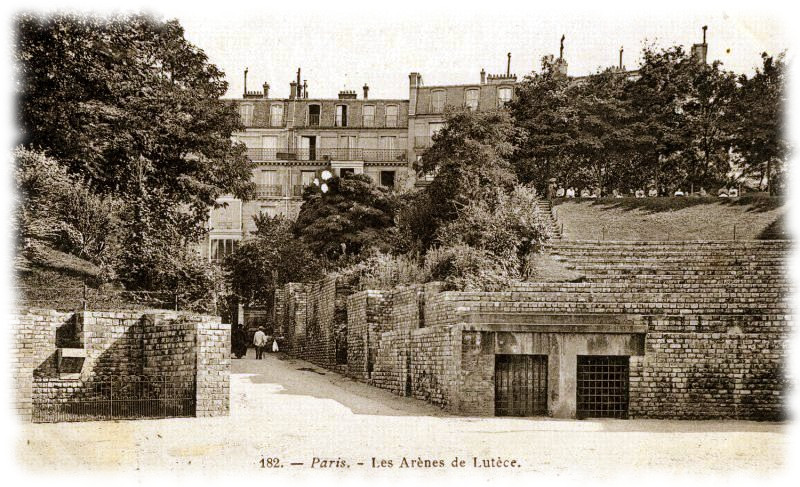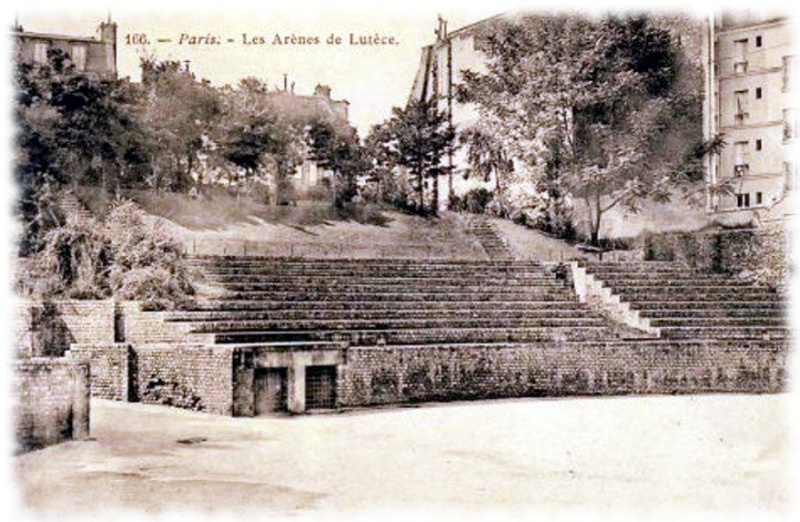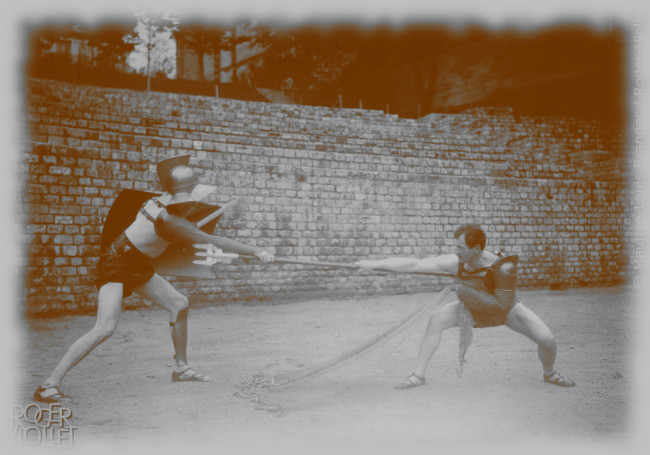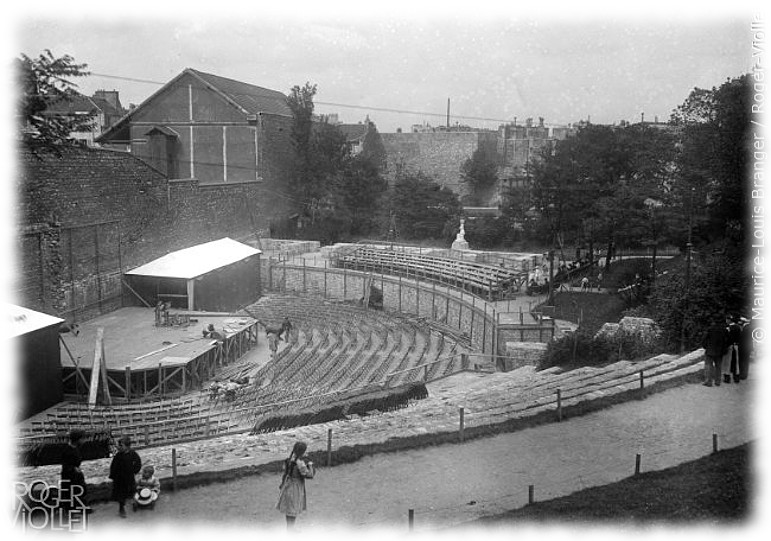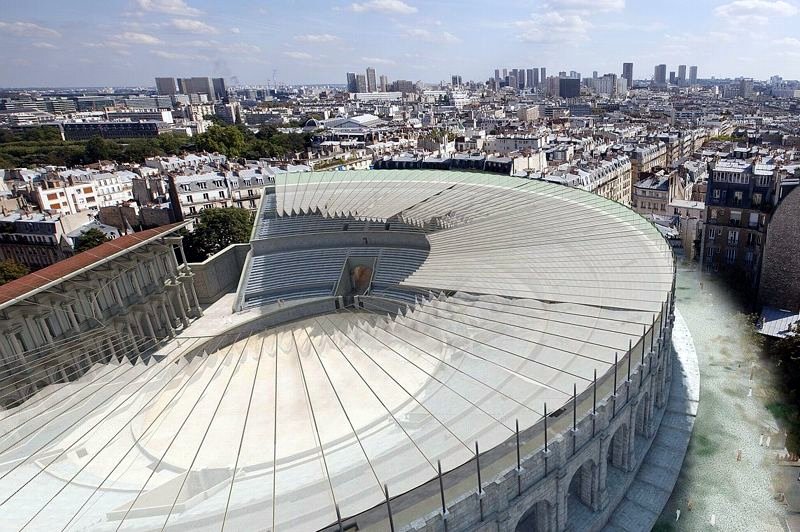Arènes de Lutèce: Difference between revisions
No edit summary |
No edit summary |
||
| (10 intermediate revisions by 2 users not shown) | |||
| Line 1: | Line 1: | ||
;[[Lutetia]] -P- [[Paris]] -P- [[ | ;[[Lutetia]] -P- [[Paris]] -P- [[5th Arrondissement]] | ||
[[File:Paris Arènes de Lutèce 1900.jpg|800px]][[File:Paris Arènes de Lutèce 1900 2.jpg|800px]] | [[File:Paris Arènes de Lutèce 1900.jpg|800px]][[File:Paris Arènes de Lutèce 1900 2.jpg|800px]] | ||
[[File:Arenes-de-lutece-paris-combat 1906.jpg|800px]][[File:Arenes de Lutece party 1912.jpg|800px]] | |||
<br> | <br> | ||
<br> | <br> | ||
| Line 20: | Line 21: | ||
Standing in the center of the arena one can still observe significant remnants of the stage and its nine niches, as well as the grilled cages in the wall. The stepped terraces are not original, but historians believe that 41 arched openings punctuated the facade. | Standing in the center of the arena one can still observe significant remnants of the stage and its nine niches, as well as the grilled cages in the wall. The stepped terraces are not original, but historians believe that 41 arched openings punctuated the facade. | ||
=== '''1900 and The Supernatural Party of the Century''' === | |||
''“Ave, Imperator: Morituri te salutant!”'' | |||
* --'''[[Ginette Nadia]]''' -- Guardian of the Arena | |||
---- | |||
<br> | |||
<br> | |||
---- | |||
== How it would appear today == | == How it would appear today == | ||
| Line 35: | Line 45: | ||
http://education.francetv.fr/matiere/antiquite/seconde/video/les-arenes-de-lutece-sous-l-empire-romain (the French history channel) | http://education.francetv.fr/matiere/antiquite/seconde/video/les-arenes-de-lutece-sous-l-empire-romain (the French history channel) | ||
https://www.pariszigzag.fr/histoire-insolite-paris/les-arenes-de-lutece-au-debut-du-xxe-siecle {''Take a look Keith''} | |||
Latest revision as of 23:17, 23 February 2025
- Lutetia -P- Paris -P- 5th Arrondissement
History
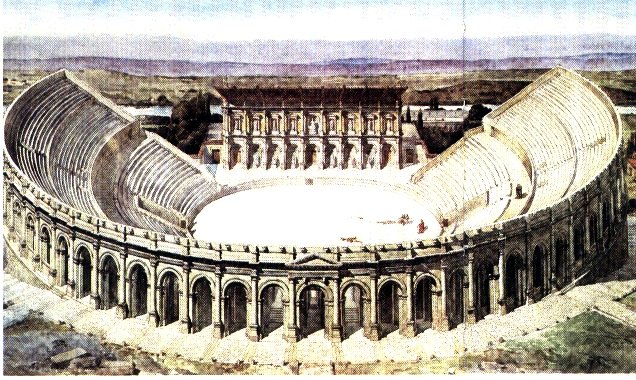
Constructed in the 1st century AD, this amphitheater is considered the longest of its kind constructed by the Romans. The sunken arena of the amphitheater was surrounded by the wall of a podium 2.5 m (8.2 feet) high, surmounted by a parapet. The presence of a 41.2-m- (135-foot-) long stage allowed scenes to alternate between theatrical productions and combat. A series of nine niches aided in improving the acoustics. Five cubbyholes were situated beneath the lower terraces, of which there appear to have been animal cages that opened directly into the arena. Historians believe that the terraces, which surrounded more than half of the arena's circumference, could accommodate as many as 17,000 spectators.
Slaves, the poor, and women were relegated to the higher tiers — while the lower seating areas were reserved for Roman male citizens. For comfort, a linen awning sheltered spectators from the hot sun. Circus acts showcased wild animals. From its vantage point, the amphitheater also afforded a spectacular view of the Bièvre and Seine rivers.
When Lutèce was sacked during the barbarian invasions of 280 A.D., some of the structure's stone work was carted off to reinforce the city's defenses around the Île de la Cité. Subsequently, the amphitheater became a cemetery, and then it was filled in completely following the construction of wall of Philippe Auguste (ca. 1210).
Centuries later, even though the surrounding neighborhood (quartier) had retained the name les Arènes, no one really knew exactly where the ancient arena had been. It was discovered by Théodore Vaquer during the building of the Rue Monge between 1860–1869, when the Compagnie Générale des Omnibus sought to build a tramway depot on the site.
Spearheaded by the author Victor Hugo (1802–1885) and a few other intellectuals, a preservation committee called la Société des Amis des Arènes undertook to save the archaeological treasure. After the demolition of the Couvent des Filles de Jésus-Christ in 1883, one-third of the arena was uncovered. The Municipal Council dedicated funds to restoring the arena and establishing it as a public square, which was opened in 1896.
After the tramway lines and depot were dismantled in 1916 and line 10 of the Paris Métro was constructed, the doctor and anthropologist Jean-Louis Capitan (1854–1929) continued with additional excavation and restoration of the arena toward the end of World War I. The neighboring Square Capitan, built on the site of the old Saint-Victor reservoir, is dedicated to his memory. Unfortunately, a portion of the original arena — opposite the stage — was lost to buildings which line rue Monge.
Standing in the center of the arena one can still observe significant remnants of the stage and its nine niches, as well as the grilled cages in the wall. The stepped terraces are not original, but historians believe that 41 arched openings punctuated the facade.
1900 and The Supernatural Party of the Century
“Ave, Imperator: Morituri te salutant!”
- --Ginette Nadia -- Guardian of the Arena
How it would appear today
Websites
http://www.discoverfrance.net/France/Paris/Parks_Gardens/Arenes_de_Lutece.shtml# (The Arènes de Lutèce at discoverfrance.net)
https://maps.google.com/maps?q=paris,+france&ll=48.844924,2.353294&spn=0.003005,0.010274&t=h&hl=enthe (the Arènes on Google Maps)
http://paris1900.lartnouveau.com/paris05/lieux/les_arenes_de_lutece_1900.htm (old photos)
http://education.francetv.fr/matiere/antiquite/seconde/video/les-arenes-de-lutece-sous-l-empire-romain (the French history channel)
https://www.pariszigzag.fr/histoire-insolite-paris/les-arenes-de-lutece-au-debut-du-xxe-siecle {Take a look Keith}
